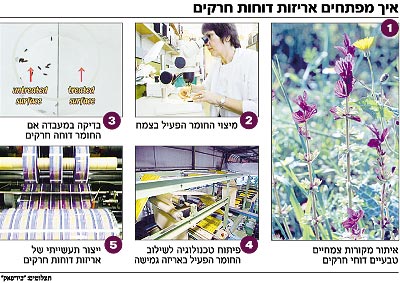Farmers in India know that locusts do not attack the azadarkat trees - there is something in the trees that repels the insects. The farmers used to make a pulp from the leaves and seeds of the tree and spread it in the fields, to protect the crops from insects. In 1965, an Indian researcher decided to check what was behind the farmers' custom. He found that the azadrach trees produce substances that prevent them from being eaten by insects as part of their defense mechanism, and he published an article about it

Prof. Fadel Mansour, from the Volcanic Institute, studies mites - tiny arthropods that are about two millimeters in size, which attack 65 plant families and cause severe damage to agriculture. "Upon reading the article, I remembered that in my childhood in the village they used to put an azadrach on the wheat to protect it from insects. I decided to investigate if the azadrachta leaves also affect acarias. I extracted the azadrach fruits in different organic solvents, and found that some of them are able to repel mites. At the same time, I started testing extracts of oils from medicinal plants and spices that I collected around the country, and I found the same phenomenon there as well," says Prof. Mansour.
The successful findings motivated Prof. Mansor to check if the plant extracts he isolated are able to repel other insects as well. "I contacted Prof. Shlomo Navarro, a friend from my school days, who also works at Volcani, and I brought the materials that I had extracted," says Mansour, "working together, we tested whether they affect warehouse insects, those that attack grains that are in storage, and we saw that it works excellently." Both researchers published their findings in the scientific literature. The results would have remained the property of science, if Mansur had not met Shmuel Shatsky about ten years ago.
Shatsky, who ran printing factories at the time, used to employ Druze soldiers in the factory who had been released from military service, and this is how the relationship between the two was created. About eight years ago Shatsky began managing a factory for the production of flexible packaging in the industrial park in Caesarea. "Mansour's stories about the natural substances that the plants secrete to repel the insects 'turned me on'," says Shatsky, "I thought, why not incorporate these substances into the plastic that is used for packaging, thus preventing the penetration of insects."
In order to realize the idea, it was necessary to find the plant from which a non-toxic insect repellent can be produced, and to develop a technology that would allow the introduction of the material into the plastic packaging, and finally to apply it on an industrial scale.
The plant chosen is an edible plant grown in Asia in large quantities, which is low in cost, and is approved for use in the human food industry by the US Food and Drug Administration. Hamma Mashgav researchers and the "Bio-Pak" company who carried out the research, developed a technology for introducing the material extracted from the plant into the plastic packaging production process. Experiments carried out showed that the substance completely prevents the penetration of the insects into the packaged food products.
"Our product is unique of its kind in the world," says Shatsky, "the potential market is huge, because it actually includes any food product that can be packaged in plastic. The cost of a complaint to a food company in whose packaging an insect was found may reach 44 thousand dollars. With our product the problems are solved. It is also important for the ultra-Orthodox sector, for kosher reasons, that insects do not enter the packaging. The ultra-orthodox market in the US reaches about 30 billion dollars a year, and this is only part of the business potential." Shatsky hopes to bring the product to market in the coming months.

3 תגובות
Azadirachtin – C35H44O16
I was told that packing cedar wood shavings in a rug keeps pests away. I would greatly appreciate someone confirming this explanation